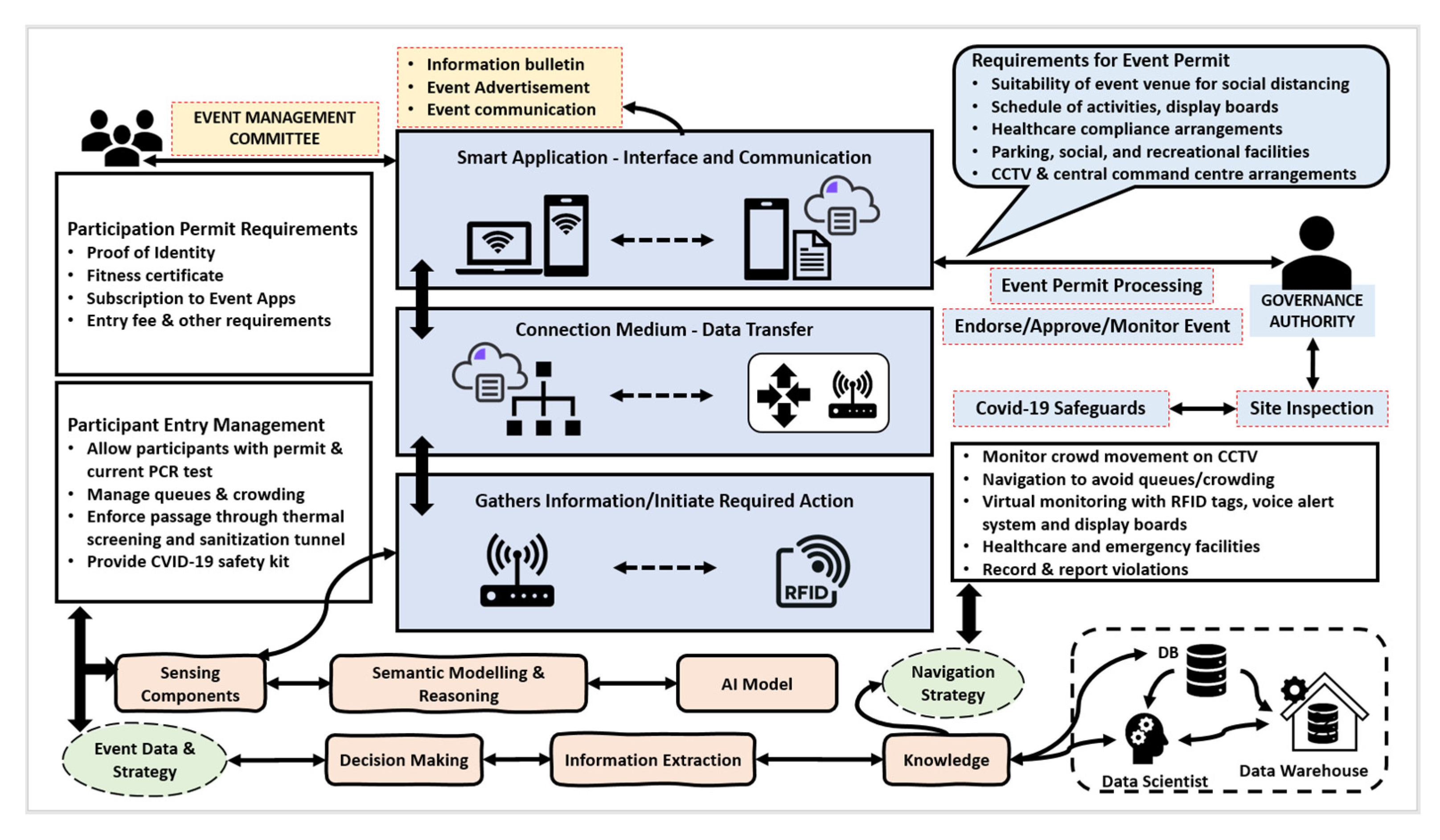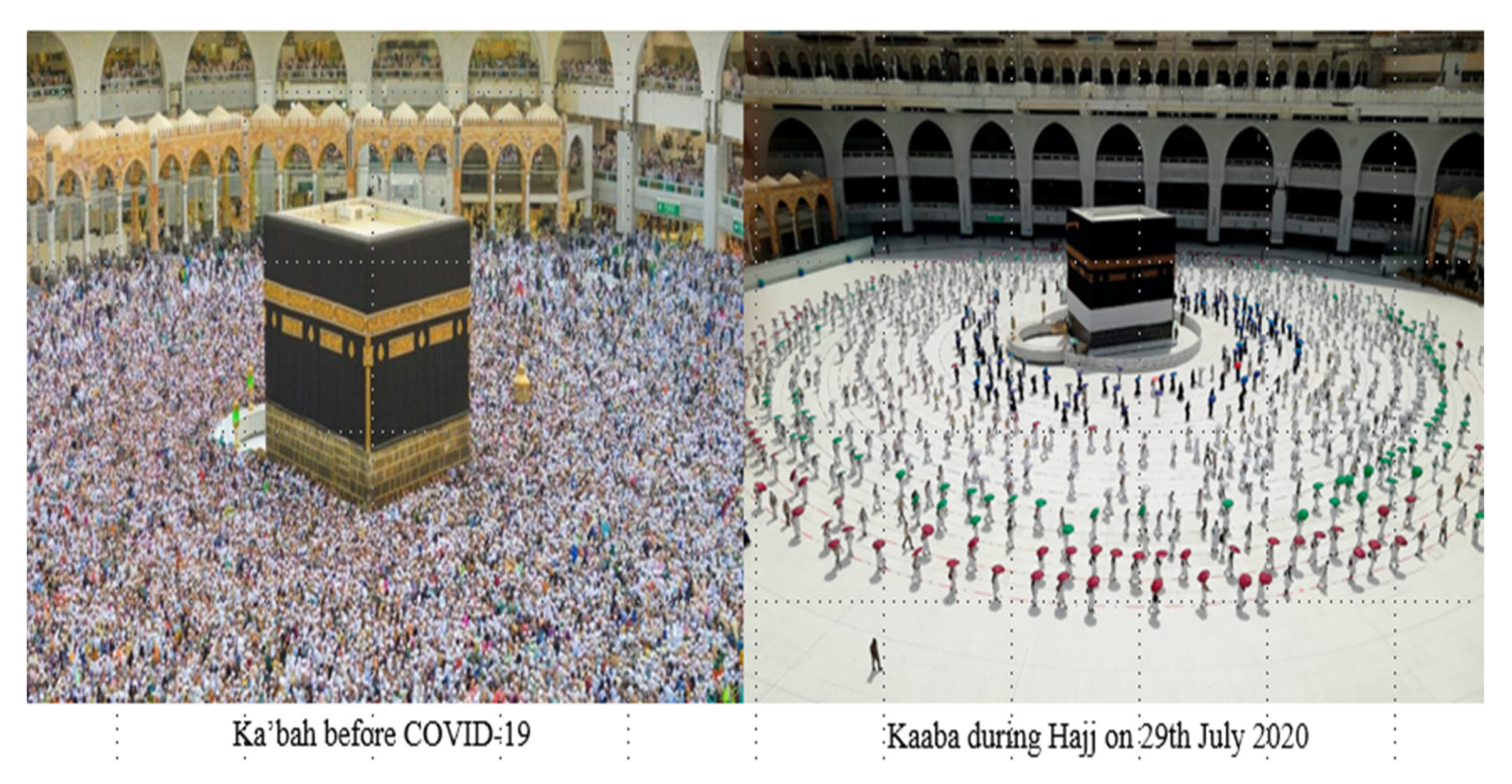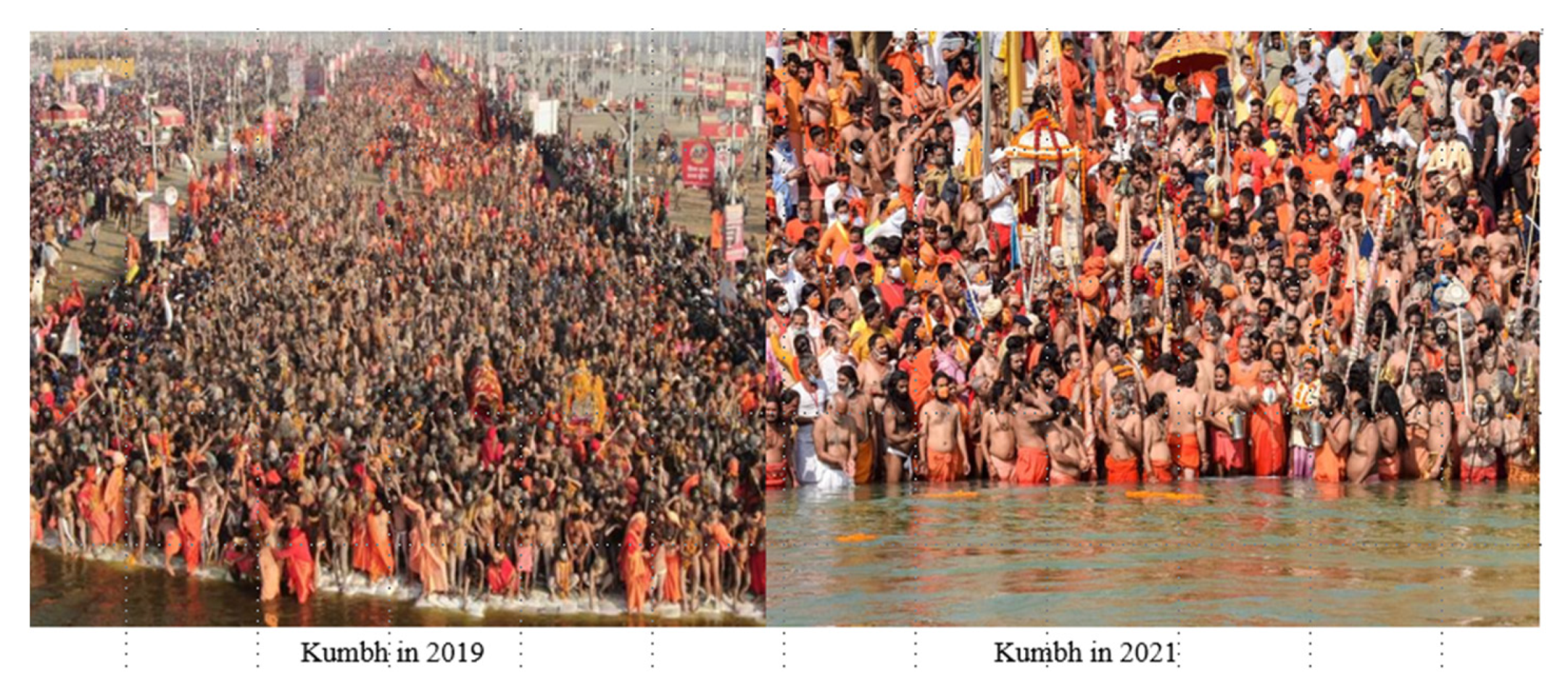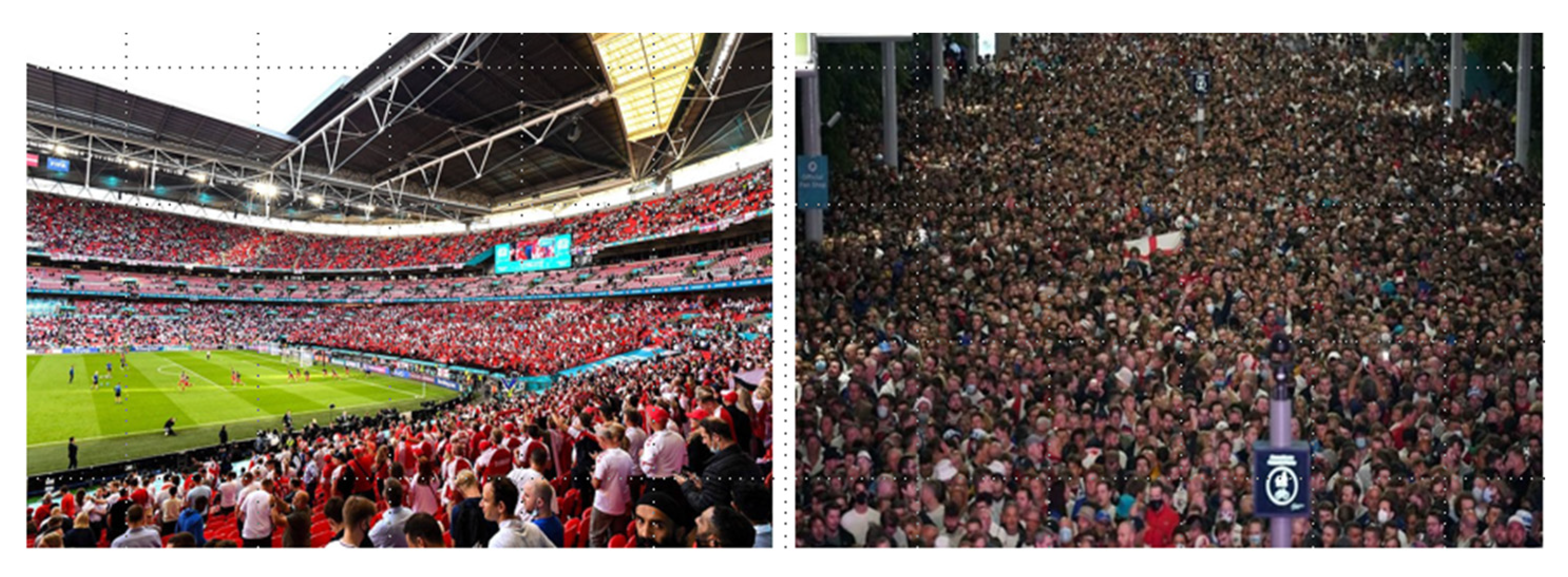A Framework for Crowd Management during COVID-19 with Artificial Intelligence
Abstract
:1. Introduction
1.1. The Hajj before and during COVID-19
1.2. Kumbh before and during COVID-19
1.3. Arbaeen before and during COVID-19
1.4. Other Crowded Events during COVID-19
1.5. Our Contribution in This Article
2. Literature Review
Classification vs. Regression
3. A Framework for Crowded Events during a Pandemic
3.1. Proposed Framework
3.1.1. Application for Interface and Communication
3.1.2. Data Transfer for Connection and Networking
3.1.3. Information Gathering from Sensing Components
3.1.4. Data Management
3.1.5. Semantic Modelling and Reasoning
- Enrich the meaning of the data being collected from various IoT sensors and actuators.
- Hide the device heterogeneity and allow for efficient integration.
3.1.6. Artificial Intelligence Model
3.1.7. Knowledge-Driven Decision Making
3.2. Algorithm for Proposed Framework
| Algorithm 1: Algorithm for Proposed Model. |
| Input: Get input/request related to event from smart mobile/web application Output: decisions to execute event or not Step-1: Start Step-2: User Apply Request for Event E1 through the System/App Step-3: System Receive the Request and Call AI_Driven_Smart_Event (E1) for Evaluation Step-4: Response to Request by Rejection or Acceptance Step-5: If Accepted then Call Event_Execute Process Step-6: Stop function AI_Driven_Smart_Event (Event_Request E1) #Start flag = Null; do // Waiting Until Final Decision Location Loc = E1.getLocation(); // Get Location of Planning Event Area Datasources ds = Get_Historical_Data_of_Area (Loc); //get collected data of selected Area // protocol = {MQTT, HTTP, CoAP} // Data will be time-series of WSNs Reads, Area Information and Capacity, Time-series of infected No. //Preprocesing_Data (ds) //Preprocess (dataset), contains many steps One_hot_encoder (ds.CategoricalPart); //label encoder for categorical data (dataset) Replacement_Null_Value (ds.NumericalPart); // Using Median or Average Function Feature_Scaling (dataset); // if there are different numeric features with different scaling [Training, Testing] = data_split (ds, 0.8, 0.2, Random); // Divide dataset to 20% for Testing Max_Accuracy = 0; Num_of_Accepted_Models = 0; Model Best_Model = Null; For i = 0 To Models.Count-1 // Models is list of common ML models (Regression and Classification) M = Apply_Machine_Learning_Model(Training, Testing, Models[i]); If (Threshold_of_Accuracy < M.Accuracy) Then Num_of_Accepted_Models ++; If (Max_Accuracy < M.Accuracy) Then Max_Accuracy = M.Accuracy; Best_Model = Models[i]; End If; End For; If (Num_of_Accepted_Models >= Threshold_of_Approve) Then flag = True; //Initial Accept for Request Else //Model_Reasoning flag = Ask_For_Manual_Decision_Admin(Best_Model, Max_Accuracy, Num_of_Accepted_Models); // Admin will show visualization results and decide manually (True or False) End If; While (flag == Null); // Until Flag has result automatically or manually If (flag) Then // If Flag = True //Check there is no other approved request for Event in the same Date flag = Check_ DateOverlapping (E1.StartDate, E1.EndDate); // Check there is no other Event in same date If (flag == False) Then Update_Request_Status (E1, “Reject”, null, “Select other Date Please”); // Rejection Else //Event_Planning Certificate C= Generate_Certificate (E1); // Certificate for Approval Update_Request_Status (E1, “Approve”, Cert, Guidelines_Doc); End If; Else Update_Request_Status (E1, “There is Threat, So the request is rejected”); // Rejection End If; Return flag; #End function Smart_Application (String eventType, Location eventLoc, Date evenStartDate, Date eventEndDate) #Start //Create New Event_Request by the received event from Input Event E1= new Event (EventType, EventLoc, eventStartDate, eventEndDate); Result = AI_Driven_Smart_Event (E1); //Send Request If (Result) Show_Alert (“Approved, Check Your Request Status for Details”); // The response of your request Else Show_Alert (“Rejection, Check Your Request Status for Reason”); // The response of your request #End |
Important Procedures and Policies for Event Execution
- Release Info_Bulletin
- Release Event_Advertisement
- //event_strategy
- Allow participants with a valid permit and a current PCR test;
- Provide a kit with essential items (i.e., mask, sanitizer, etc.) and a leaflet of information;
- Manage queues by enforcing adequate social distancing;
- Thermal screening, passing through a sanitization tunnel;
- Provide RFID-tagged bracelet for tracking and providing emergency help
- //navigation_strategy;
- Monitor crowd movement on CCTV;
- Manage movement to prevent crowding;
- Track individuals with RFID tags as and when required;
- Broadcast alerts through loud speakers and billboards;
- Provide healthcare and emergency support;
- Report violations.
- Collect, store, and manage data from activities and devices (sensors, reports, etc.) for current and future use.
3.3. Explanations of Main Functions of the Algorithm
- The applicant (host/owner/event management committee) would use the Smart Application form to apply for an event permit by inputting the type, location, number of participants, and start and end dates of the event.
- The Smart Application function will then receive it as a new request and start evaluating the request by invoking the “Smart Event” function, which would process the application through the following steps:
- Historical data about the selected location (from previous event(s)), which include reports of incidents and infections of previous events for the selected area, would be retrieved. Data from IoT sensors about the pollution and congestion or crowd ratio of the area (time-series) will also be analyzed.
- Preprocessing of the available data according to its type (numeric or nominal) would take place, which would consist of replacing the null values, scaling numeric values, and encoding the nominal values.
- The function will then apply common machine learning (ML) models (by going through each of them, one by one), and calculate the accuracy of each step. Note that the function has a list of common ML classification models (managed by the admin), for example, linear regression, log regression, SVM, naive Bayes, decision tree, etc. Thus, the proposed framework depends on different kinds of machine learning models, not just regression but also classification.
- Then, the data will be divided randomly, with training being 80% and testing making up the other 20%.
- The function will calculate the number of models that have an acceptable accuracy (larger than a specific threshold).
- The function will compare all accuracy values and find the ML model with the maximum value and save this result (to support the admin when managing the list of ML models in the future).
- The function will check if the number of accepted models is large enough (the threshold can be adjusted by the admin). If so, the function will accept the request automatically when it is verified that there are no threats in this area to host the event.
- In case the number of accepted models is less than the threshold, the function will request manual reviewing with the accuracy result of the best ML model, in addition to the number of accepted ones.
- If the return decision is to reject the application, the function will send an alert to the applicant citing safety concerns.
- If the automatic or manual decision was to approve, the function will check for the availability of the date(s). If the desired date(s) is not available, the function will send a rejection message and advise the applicant to choose another date(s).
- If the applicant’s request is approved, the function will update the status of the request, notify the applicant, send guidelines, generate the certificate of approval, and invoke the Execute Event function (to send an alert to teams to start the process of preparations).
- It should be noted that we mentioned an important procedure, which contains a number of tasks related to the organization of the event (e.g., alert teams, send ads, monitoring event condition, and feedback). However, all data collected from sensors during the event will automatically be sent to the cloud, as shown in the proposed framework.
- Feedback and other relevant data will be merged with previous historical data for future evaluation.
3.3.1. Factors for Validation for ML Model
Optimization: Avoiding Model over Fit with an Additional Handout Set
3.3.2. K-Fold Cross Verification
- Using classic F-fold cross validation by splitting data into k-folds, k = 5;
- Observations: All combinations and averages of both the test and validation observations;
- Validated against: Computational complexity and validation accuracy;
- Optimization: Improving stability of the machine learning model across several data inputs.
3.3.3. Nested Cross Validation
- Using nested cross validation strategy;
- Observations: Use inner loop (two-fold) for hyper parameter tuning, use outer loop (five-fold) for accuracy estimation;
- Validated against: Error estimation;
- Optimization: Improving hyper parameter tuning and estimating accuracy.
3.3.4. Time-Series Cross Validation
- Using F-fold CV by splitting data into k-folds;
- Observations: Entire training data occurs before your test data;
- Validated against: Over fitting;
- Optimization: Improving stability of the machine learning model across several data inputs.
3.3.5. Model Comparison
- Using method 5 × 2CV paired t-test from Scikit-learn Python machine learning library;
- Observations: Statistically significant;
- Validated against: p-value;
- Optimization: Choose the best model.
3.3.6. Future Research
4. Conclusions
Author Contributions
Funding
Conflicts of Interest
References
- Wu, Y.-C.; Chen, C.-S.; Chan, Y.-J. The outbreak of COVID-19: An overview. J. Chin. Med. Assoc. 2020, 83, 217–220. [Google Scholar] [CrossRef] [PubMed]
- Planas, D.; Veyer, D.; Baidaliuk, A.; Staropoli, I.; Guivel-Benhassine, F.; Rajah, M.M.; Planchais, C.; Porrot, F.; Robillard, N.; Puech, J.; et al. Reduced sensitivity of SARS-CoV-2 variant Delta to antibody neutralization. Nature 2021, 596, 276–280. [Google Scholar] [CrossRef] [PubMed]
- Solís Arce, J.S.; Warren, S.S.; Meriggi, N.F.; Scacco, A.; McMurry, N.; Voors, M.; Syunyaev, G.; Malik, A.A.; Aboutajdine, S.; Adeojo, O.; et al. COVID-19 vaccine acceptance and hesitancy in low- and middle-income countries. Nat. Med. 2021, 27, 1385–1394. [Google Scholar] [CrossRef]
- Loomba, S.; de Figueiredo, A.; Piatek, S.J.; de Graaf, K.; Larson, H.J. Measuring the impact of COVID-19 vaccine misinformation on vaccination intent in the UK and USA. Nat. Hum. Behav. 2021, 5, 337–348, Correction in 2021, 5, 960. [Google Scholar] [CrossRef]
- Pouwels, K.B.; Pritchard, E.; Matthews, P.C.; Stoesser, N.; Eyre, D.W.; Vihta, K.-D.; House, T.; Hay, J.; Bell, J.I.; Newton, J.N.; et al. Effect of Delta variant on viral burden and vaccine effectiveness against new SARS-CoV-2 infections in the UK. Nat. Med. 2021, 27, 1–9. [Google Scholar] [CrossRef] [PubMed]
- Nalbandian, A.; Sehgal, K.; Gupta, A.; Madhavan, M.V.; McGroder, C.; Stevens, J.S.; Cook, J.R.; Nordvig, A.S.; Shalev, D.; Sehrawat, T.S.; et al. Post-acute COVID-19 syndrome. Nat. Med. 2021, 27, 601–615. [Google Scholar] [CrossRef]
- Arora, A. COVID-19: Saudi Authorities Say Only ‘immunised’ Pilgrims Will Be Allowed in Mecca. Republic World. 2021. Available online: https://www.republicworld.com/world-news/middle-east/covid-19-saudi-authorities-say-only-immunised-pilgrims-will-be-allowed-in-mecca.html (accessed on 30 September 2021).
- Kalebi, A. Pilgrimage in a Pandemic: Lessons from Mecca on Containing Covid-19. Business Standard. 2021. Available online: https://www.business-standard.com/article/current-affairs/pilgrimage-in-a-pandemic-lessons-from-mecca-on-containing-covid-19-121051500151_1.html (accessed on 30 September 2021).
- WHO Chief Lauds Saudi Arabia’s Coronavirus Measures During Hajj. Saudi Gazette. Available online: https://www.saudigazette.com.sa/article/608957/SAUDI-ARABIA/WHO-chief-lauds-Saudi-Arabias-coronavirus-measures-during-Hajj (accessed on 30 September 2021).
- Kumbh, M. 2019: At Rs 4,236 Crore, This Year’s Mela in Prayagraj is Costliest Ever. Business Today. 2019. Available online: https://www.businesstoday.in/latest/economy-politics/story/kumbh-mela-2019-at-rs-4236-crore-this-year-mela-costliest-ever-160612-2019-01-16 (accessed on 30 September 2021).
- Nearly 50 Kumbh Mela Visitors Test Positive for COVID-19 on Returning to Gujarat. India Today, 2021.
- Kumbh, M. The World’s Largest Religious Gathering Sets 3 World Records. Business Insider (India). Available online: https://www.businessinsider.in/kumbh-mela-2019-sets-3-guinness-world-record/articleshow/68250313.cms (accessed on 30 September 2021).
- Govt data. 9.1 Million thronged Mahakumbh Despite COVID-19 Surge. Hindustan Times. Available online: https://www.hindustantimes.com/cities/dehradun-news/91-million-thronged-mahakumbh-despite-covid-19-surge-govt-data-101619729096750.html (accessed on 30 September 2021).
- NDTV Coronavirus, April 14, 2021, over 1700 Test COVID-19 Positive at Haridwar Kumbh over 5 Days. Available online: https://www.ndtv.com/india-news/over-1-700-test-covid-19-positive-at-haridwar-kumbh-over-5-days-official-2414270 (accessed on 30 September 2021).
- AFP. Arbaeen: ‘If You Want to See Humanity Living and Breathing, Experience This Walk’. The Express Tribune. 2018. Available online: https://tribune.com.pk/article/74031/arbaeen-if-you-want-to-see-humanity-living-and-breathing-experience-this-walk (accessed on 30 September 2021).
- Tasnim. No Foreign Pilgrims Allowed in Iraq for Arbaeen. Iraq Business News. 2020. Available online: https://www.iraq-businessnews.com/2020/09/02/no-foreign-pilgrims-allowed-in-iraq-for-arbaeen/ (accessed on 30 September 2021).
- GettyImages. Euro 2020: Fans Euphoric as England Beat Denmark to Reach Final. BBC. 2021. Available online: https://www.bbc.com/news/in-pictures-57743446 (accessed on 30 September 2021).
- Sarmah, B. Euro 2020 and a Fresh Spike in COVID-19 Cases. Hindustan Times. 2021. Available online: https://www.hindustantimes.com/sports/football/euro-2020-and-a-fresh-spike-in-covid-19-cases-101625844271740.html (accessed on 30 September 2021).
- Yamin, M.; Ades, Y. Crowd Management with RFID and Wireless Technologies. In Proceedings of the 2009 First International Conference on Networks & Communications, Chennai, India, 27–29 December 2009; pp. 439–442. [Google Scholar] [CrossRef]
- Yamin, M.; Basahel, A.M.; Abi Sen, A.A. Managing Crowds with Wireless and Mobile Technologies. Wirel. Commun. Mob. Comput. 2018, 2018, 1–15. [Google Scholar] [CrossRef] [Green Version]
- Felemban, E.; Sheikh, A.A.; Naseer, A. Improving Response Time for Crowd Management in Hajj. Computers 2021, 10, 46. [Google Scholar] [CrossRef]
- Owaidah, A.; Olaru, D.; Bennamoun, M.; Sohel, F.; Khan, N. Review of Modelling and Simulating Crowds at Mass Gathering Events: Hajj as a Case Study. J. Artif. Soc. Soc. Simul. 2019, 22, 1–36. [Google Scholar] [CrossRef]
- Polanco, L.D.; Siller, M. Crowd management COVID-19. Annu. Rev. Control. 2021, 52, 465–478. [Google Scholar] [CrossRef] [PubMed]
- Templeton, A. Future research avenues to facilitate social connectedness and safe collective behavior at organized crowd events. Group Process. Intergroup Relat. 2021, 24, 216–222. [Google Scholar] [CrossRef]
- Bardesi, H.; Al-Mashaikhi, A.; Basahel, A.; Yamin, M. COVID-19 compliant and cost effective teaching model for King Abdulaziz University. Int. J. Inf. Technol. 2021, 13, 1343–1356. [Google Scholar] [CrossRef]
- Bajaba, S.; Mandurah, K.; Yamin, M. A framework for pandemic compliant higher education national system. Int. J. Inf. Technol. 2021, 13, 407–414. [Google Scholar] [CrossRef]
- Yamin, M.; Abi Sen, A.A.; AlKubaisy, Z.M.; Almarzouki, R. A Novel Technique for Early Detection of COVID-19. Comput. Mater. Contin. 2021, 68, 2283–2298. [Google Scholar] [CrossRef]
- Khanday, A.M.U.D.; Rabani, S.T.; Khan, Q.R.; Rouf, N.; Din, M.M.U. Machine learning based approaches for detecting COVID-19 using clinical text data. Int. J. Inf. Technol. 2020, 12, 731–739. [Google Scholar] [CrossRef]
- Yadav, R.S. Data analysis of COVID-2019 epidemic using machine learning methods: A case study of India. Int. J. Inf. Technol. 2020, 12, 1321–1330. [Google Scholar] [CrossRef]
- Khanday, A.M.U.D.; Khan, Q.R.; Rabani, S.T. Identifying propaganda from online social networks during COVID-19 using machine learning techniques. Int. J. Inf. Technol. 2021, 13, 115–122. [Google Scholar] [CrossRef] [PubMed]
- Ministry of Hajj and Umrah. Available online: https://www.haj.gov.sa/en (accessed on 30 September 2021).
- Yamin, M. Managing crowds with technology: Cases of Hajj and Kumbh Mela. Int. J. Inf. Technol. 2019, 11, 229–237. [Google Scholar] [CrossRef]
- Nikjoo, A.; Sharifi-Tehrani, M.; Karoubi, M.; Siyamiyan, A. From Attachment to a Sacred Figure to Loyalty to a Sacred Route: The Walking Pilgrimage of Arbaeen. Religions 2020, 11, 145. [Google Scholar] [CrossRef] [Green Version]
- Tajti, T. Fuzzification of training data class membership binary values for neural network algorithms. Annal. Math. Inform. 2020, 52, 217–228. [Google Scholar] [CrossRef]
- Tajti, T. New voting functions for neural network algorithms. Annal. Math. Inform. 2020, 52, 229–242. [Google Scholar] [CrossRef]

Publisher’s Note: MDPI stays neutral with regard to jurisdictional claims in published maps and institutional affiliations. |
© 2021 by the authors. Licensee MDPI, Basel, Switzerland. This article is an open access article distributed under the terms and conditions of the Creative Commons Attribution (CC BY) license (https://creativecommons.org/licenses/by/4.0/).
Share and Cite
Almutairi, M.M.; Yamin, M.; Halikias, G.; Abi Sen, A.A. A Framework for Crowd Management during COVID-19 with Artificial Intelligence. Sustainability 2022, 14, 303. https://doi.org/10.3390/su14010303
Almutairi MM, Yamin M, Halikias G, Abi Sen AA. A Framework for Crowd Management during COVID-19 with Artificial Intelligence. Sustainability. 2022; 14(1):303. https://doi.org/10.3390/su14010303
Chicago/Turabian StyleAlmutairi, Mishaal M., Mohammad Yamin, George Halikias, and Adnan Ahmed Abi Sen. 2022. "A Framework for Crowd Management during COVID-19 with Artificial Intelligence" Sustainability 14, no. 1: 303. https://doi.org/10.3390/su14010303
APA StyleAlmutairi, M. M., Yamin, M., Halikias, G., & Abi Sen, A. A. (2022). A Framework for Crowd Management during COVID-19 with Artificial Intelligence. Sustainability, 14(1), 303. https://doi.org/10.3390/su14010303









